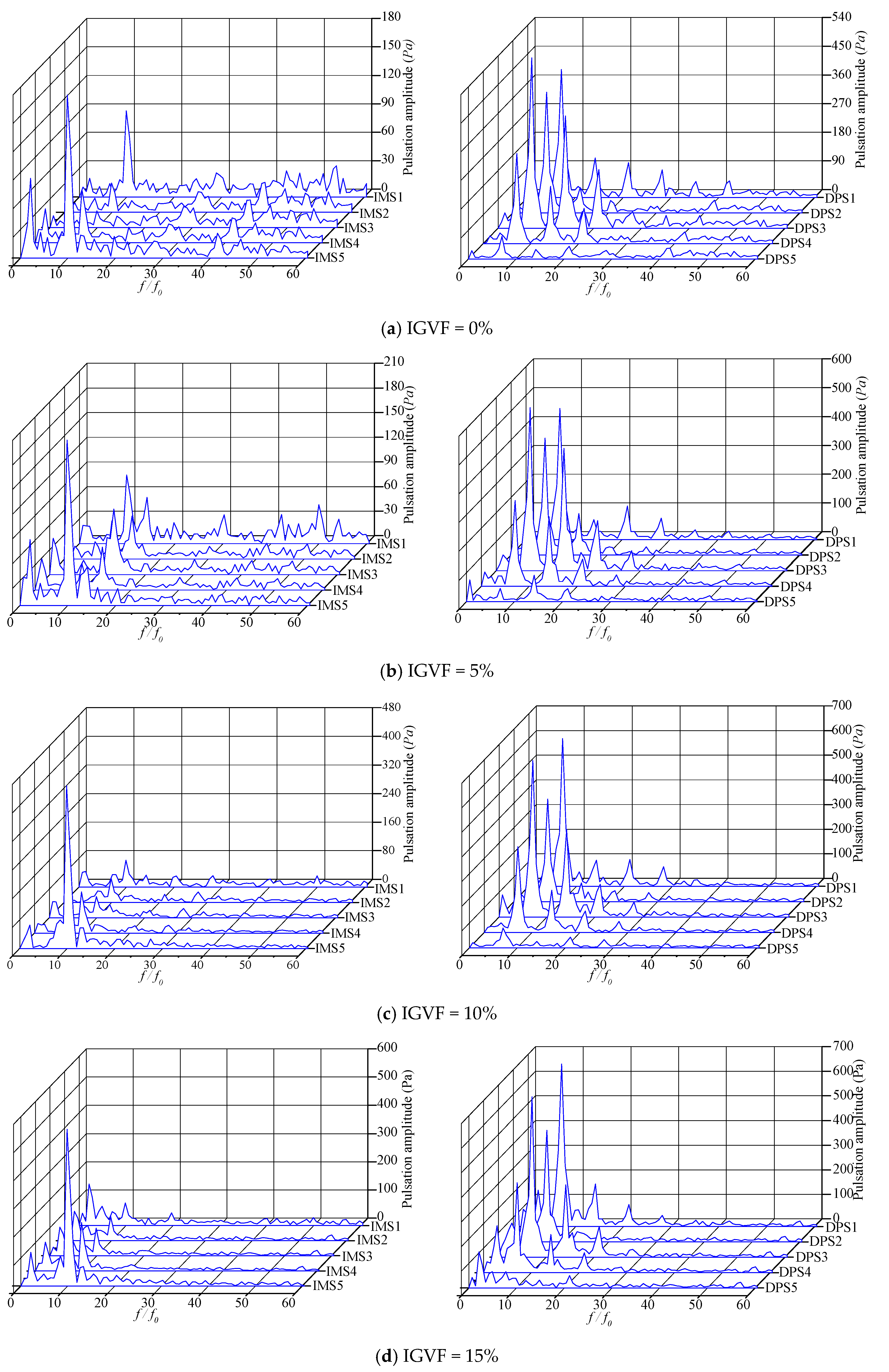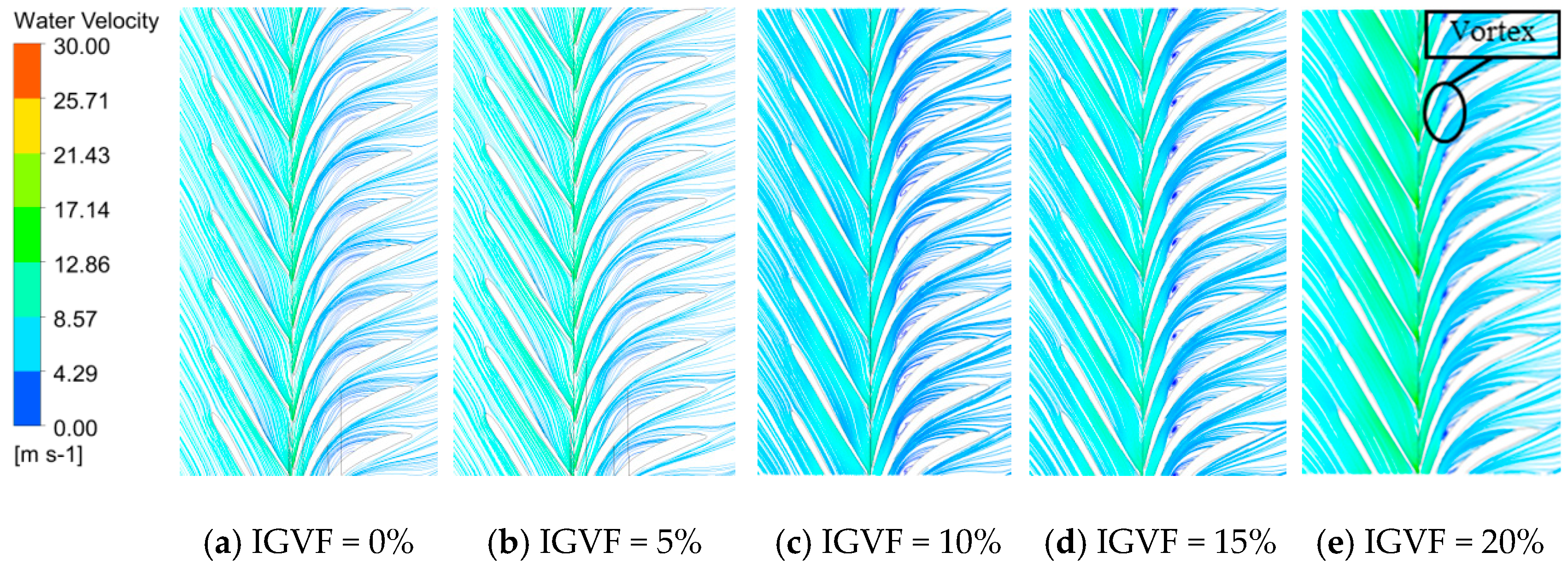Effects of Gas-Volume Fractions on the External Characteristics and Pressure Fluctuation of a Multistage Mixed-Transport Pump
Abstract
:1. Introduction
2. Model and Mesh Generation
2.1. Physical Model
2.2. Grid Division and Monitoring Point Setting
3. Numerical Methodology and Experimental Verification
3.1. Numerical Methods and Solution Settings
3.2. Mesh Validation
3.3. Experimental Verification
4. Numerical Results and Analysis
4.1. Pressure Distribution
4.2. Pressure Pulsation Analysis
4.3. Gas Phase Distribution
4.4. Liquid Relative Velocity Distribution
5. Conclusions
- (1)
- For the same experimental and numerical simulation conditions, the pressurization capacity of the multiphase mixed-transport pump decreased gradually with increasing flow rate. The efficiency improvement of this pump was limited with increasing flow rates. Meanwhile, the relative discharge of the IGVF and the decrease of the pump head had a quantitative relationship under a rated-flow condition. The pressurization capacity of the mixed-transport pump decreased with increasing the IGVFs. At the equal flow rate condition, the pressurization capacity of the mixed pump decreased by more than 30% when the IGVF was greater than 13.5%.
- (2)
- The amplitude of the pressure pulsation close to the impeller blade head suction surface increased gradually along the flow orientation. With increasing IGVFs, the pressure fluctuation intensity at the impeller and diffuser inlet increased significantly. This phenomenon was closely correlated with the gas accumulation and the low relative velocity area.
- (3)
- The main frequency amplitude increased continuously with increasing gas content. In most cases, the dominant frequency of the impeller was 583.3 Hz, which was affected by the diffuser vanes number, whose value is the product of the rotation frequency and the number of guide vanes. The same situation happened in the diffuser, where the dominant frequency value was 408.3 Hz and was seven times that of the rotation frequency. It was shown that the pressure pulsation dominant frequency was an integer multiple of the rotation frequency.
- (4)
- The gas in the impeller passage primarily gathered on the suction surface of the blade head close to the front cover plate. Due to the work of the centrifugal forces, the water was pushed to the back cover plate, increasing the GVF near the front cover plate. On the blade suction surface near the front cover plate, a low-velocity area caused by the flow separation was generated. Thus, the pressure pulsation of the impeller was further affected. Vortices in the diffuser were obvious, and the vortex position tended to move toward the inlet of the diffuser with increasing gas content.
Author Contributions
Funding
Conflicts of Interest
References
- Li, F. Innovative application of multiphase transport pump. Intern. Combust. Engine Parts 2019, 5, 203–204. [Google Scholar]
- Yang, X.; Qu, Z.; Wu, Y. Frictional Loss Studies and Experimental Performance of a New Synchronal Rotary Multiphase Pump. J. Fluids Eng. 2011, 133, 041303. [Google Scholar] [CrossRef]
- Zhang, J.Y.; Li, Y.J.; Cai, S.J.; Zhu, H.W.; Zhang, Y.X. Investigation on the gas pockets in a rotodynamic multiphase pump. IOP Conf. Ser. Mater. Sci. Eng. 2016, 129, 012007. [Google Scholar] [CrossRef] [Green Version]
- Kim, J.H.; Lee, H.C.; Kim, J.H.; Lee, Y.K.; Choi, Y.S. Reliability Verification of the Performance Evaluation of Multiphase Pump. Int. J. Mech. Mechatron. Eng. 2014, 24, 1782–1786. [Google Scholar]
- Li, Z.; Sun, Z.; Zhang, Q.; Feng, L.; Yu, R. Numerical Simulation and Experiment of Gas-liquid Two Phase Flow at Inlet of Underwater Multiphase Pump. China Pet. Mach. 2018, 46, 50–55. [Google Scholar]
- Shi, G.; Wang, Z.; Luo, K. Analysis of the Turbulent Flow Intensity and Dissipation Characteristics of an Oil-gas Multiphase Pump in Its Compression Stages. J. Eng. Therm. Energy Power 2018, 33, 115–121. [Google Scholar]
- Yu, Z.Y.; Zhu, B.S.; Cao, S.L. Interphase force analysis for air-water bubbly flow in a multiphase rotodynamic pump. Eng. Comput. 2015, 32, 2166–2180. [Google Scholar] [CrossRef] [Green Version]
- Räbiger, K.; Maksoud, T.M.A.; Ward, J.; Hausmann, G. Theoretical and experimental analysis of a multiphase screw pump, handling gas–liquid mixtures with very high gas volume fractions. Exp. Therm. Fluid Sci. 2008, 32, 1694–1701. [Google Scholar] [CrossRef]
- Yu, Z.Y.; Zhang, Q.Z.; Huang, R.; Cao, S.L. Numerical analysis of gas-liquid mixed transport process in a multiphase rotodynamic pump. IOP Conf. Ser. Earth Environ. Sci. 2012, 15, 32–62. [Google Scholar] [CrossRef]
- Serena, A.; Bakken, L.E. Flow Visualization of Unsteady and Transient Phenomena in a Mixed-Flow Multiphase Pump. In Proceedings of the Turbo-Machinery Technical Conference and Exposition, Seoul, Korea, 13–17 June 2016; Volume 6, pp. 13–17. [Google Scholar]
- Zhang, J.; Zhu, H.; Yang, C.; Li, Y.; Wei, H. Multi-objective shape optimization of helico-axial multiphase pump impeller based on NSGA-II and ANN. Energy Convers. Manag. 2011, 52, 538–546. [Google Scholar] [CrossRef]
- Lei, T.; Zhifeng, X.; Yabin, L. Influence of T-shape tip clearance on performance of a mixed-flow pump. Proc. Inst. Mech. Eng. Part A J. Power Energy 2017, 232, 386–396. [Google Scholar] [CrossRef]
- Zhang, W.; Yu, Z.; Li, Y.; Cheng, X. Flow Characteristics Analysis for the Whole Flow Passage of a Multiphase Rotodynamic Pump. J. Mech. Eng. 2019, 55, 168–174. [Google Scholar] [CrossRef] [Green Version]
- Zhang, J.; Zhu, H.; Li, Y.; Yang, C. Shape Optimization of Helico-axial Multiphase Pump Impeller Based on Genetic Algorithm. In Proceedings of the 2009 Fifth International Conference on Natural Computation, Tianjin, China, 14–16 August 2009; pp. 408–412. [Google Scholar]
- Zhang, J.; Cai, S.; Li, Y.; Zhu, H.; Zhang, Y. Visualization study of gas-liquid two-phase flow patterns inside a three-stage rotodynamic multiphase pump. Exp. Therm. Fluid Sci. 2016, 70, 125–138. [Google Scholar] [CrossRef]
- Zhang, Y.; Zhang, J.; Zhu, H.; Cai, S. 3D Blade Hydraulic Design Method of the Rotodynamic Multiphase Pump Impeller and Performance Research. Adv. Mech. Eng. 2014, 6, 803972. [Google Scholar] [CrossRef]
- Kim, J.H.; Lee, H.C.; Yoon, J.Y.; Lee, K.Y.; Lee, Y.K.; Choi, Y.S. Multi Objective Optimization of a Multiphase Pump for Offshore Plants. In Proceedings of the ASME 2014 4th Joint Us-European Fluids Engineering Division Summer Meeting, Chicago, IL, USA, 3–7 August 2014; Volume 8, pp. 3–7. [Google Scholar]
- Serena, A.; Bakken, L.E. Design of a Multiphase Pump Test Laboratory Allowing to Perform Flow Visualization and Instability Analysis. In Proceedings of the ASME Power Conference, San Diego, CA, USA, 28 June–2 July 2015; Volume 28, pp. 6–27. [Google Scholar]
- Tan, L.; Zhu, B.; Wang, Y.; Cao, S.; Gui, S. Numerical study on characteristics of unsteady flow in a centrifugal pump volute at partial load condition. Eng. Comput. 2015, 32, 1549–1566. [Google Scholar] [CrossRef]
- Liu, M.; Tan, L.; Cao, S.L. Design method of controllable blade angle and orthogonal optimization of pressure rise for a multiphase pump. Energies 2018, 11, 1048. [Google Scholar] [CrossRef] [Green Version]













| Component | Designation | Parameters |
|---|---|---|
| Design point | Rated discharge (Qd, m3/h) | 26.5 |
| Rated lift (Pr, KPa) | 260 | |
| Rated revolution (n, r/min) | 3500 | |
| Impeller | Number of blade (Zi) | 7 |
| Inlet inner diameter (D1, mm) | 62.23 | |
| Outlet inner diameter (D2, mm) | 127 | |
| Diffuser | Number of vane (Zd) | 10 |
| Inlet inner diameter (D3, mm) | 150 | |
| Outlet inner diameter (D4, mm) | 65.49 |
| Items | Mesh I | Mesh II | Mesh III | Mesh IV | Mesh V |
|---|---|---|---|---|---|
| Total grid number | 3,072,474 | 5,378,384 | 6,604,412 | 7,734,156 | 9,283,628 |
| Pressure rise (kPa) | 776.12 | 784.52 | 788.61 | 789.20 | 789.10 |
| Efficiency (%) | 78.25 | 80.45 | 80.51 | 80.57 | 80.59 |
| Relative pressure rise Pr/Pd1 | 1 | 1.0108 | 1.0161 | 1.0168 | 1.0167 |
| Relative efficiency η/ηc | 1 | 1.0025 | 1.0032 | 1.0040 | 1.0041 |
| Conditions | Head_CFD (m) | Head_EXP (m) | Variation (%) |
|---|---|---|---|
| IGVF = 0 | 79.63 | 78.82 | 1.03% |
| IGVF = 5% | 74.75 | 73.55 | 1.63% |
| IGVF = 10% | 65.28 | 63.42 | 2.93% |
| IGVF = 15% | 53.79 | 51.71 | 4.02% |
| IGVF = 20% | 43.25 | 41.26 | 4.82% |
| IGVF = 25% | 35.05 | 32.63 | 7.41% |
© 2020 by the authors. Licensee MDPI, Basel, Switzerland. This article is an open access article distributed under the terms and conditions of the Creative Commons Attribution (CC BY) license (http://creativecommons.org/licenses/by/4.0/).
Share and Cite
Li, C.; Luo, X.; Feng, J.; Zhu, G.; Xue, Y. Effects of Gas-Volume Fractions on the External Characteristics and Pressure Fluctuation of a Multistage Mixed-Transport Pump. Appl. Sci. 2020, 10, 582. https://doi.org/10.3390/app10020582
Li C, Luo X, Feng J, Zhu G, Xue Y. Effects of Gas-Volume Fractions on the External Characteristics and Pressure Fluctuation of a Multistage Mixed-Transport Pump. Applied Sciences. 2020; 10(2):582. https://doi.org/10.3390/app10020582
Chicago/Turabian StyleLi, Chenhao, Xingqi Luo, Jianjun Feng, Guojun Zhu, and Yangang Xue. 2020. "Effects of Gas-Volume Fractions on the External Characteristics and Pressure Fluctuation of a Multistage Mixed-Transport Pump" Applied Sciences 10, no. 2: 582. https://doi.org/10.3390/app10020582




